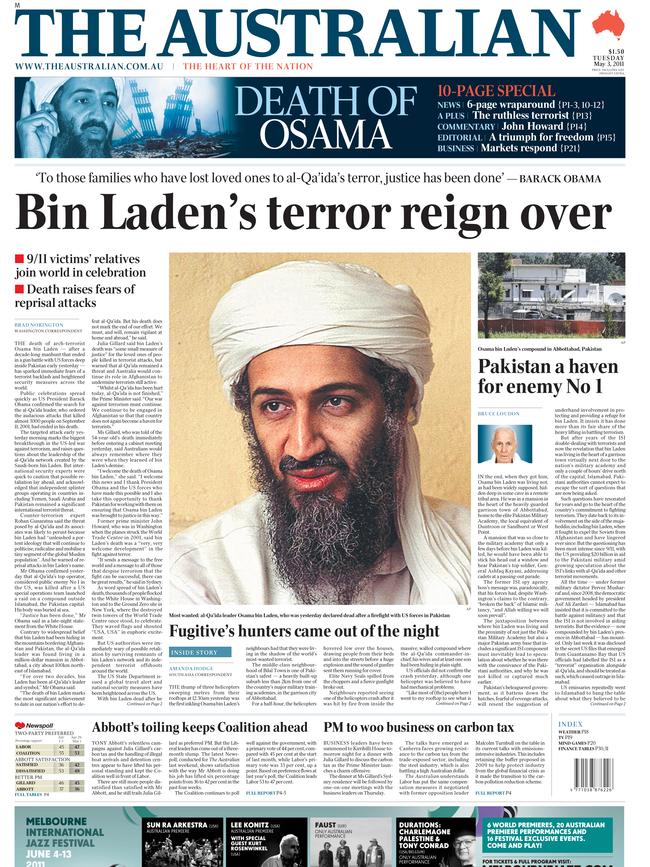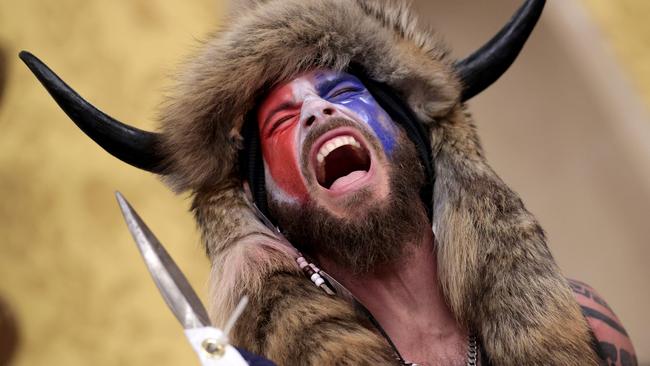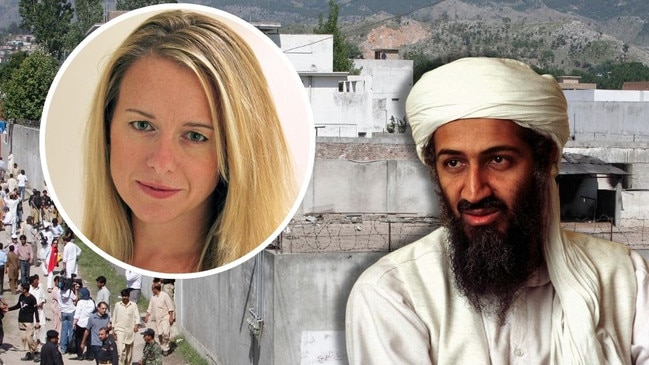Inside story: How Osama bin Laden hid in plain sight
The Australian’s then-South Asian correspondent had numerous run-ins with armed Pakistani police while covering the story of the decade. But nothing they could dish out could have been worse than having to tell the editor she’d been kicked out.

“Hodgey, wake up. Osama bin Laden is dead.”
The biggest news of the decade was delivered down the phone from Sydney barely three hours after I’d gone to bed following one of the most ill-advised Sunday night knees-ups known to journalism.
In the early hours of May 2, 2011, a team of US navy SEALs had choppered over the border from Afghanistan to Pakistan and assassinated the world’s most wanted terrorist in a residential compound a short walk from Pakistan’s most prestigious military college.
I stumbled into the third bedroom of our New Delhi apartment – The Australian’s New Delhi bureau – to find the quickest route to Abbottabad, and enough fresh detail to pull together 1800 words before a noon flight.
It would not be easy.
Nothing is when it comes to India-Pakistan relations thanks to decades of mutual suspicion between two nations that were once one, and it would take me almost 24 hours to get there. Yet that ridiculous route – from Delhi to Pakistan’s southern port of Karachi then back up north to Islamabad and overland northwest to Abbottabad – would be the prelude to one of the greatest, most rollicking working weeks of my life.

As Islamabad’s blindsided security establishment debated how to respond to the news – should they play along and claim some credit for the raid or protest a gross breach of trust by a powerful ally – I scrambled over the border with a pack of correspondents fizzing with excitement, and into a leafy highland town that was once a cantonment for British forces.
Those without valid visas were sunk but those of us who made it were in for a treat.
Abbottabad was a story wonderland that week; from the local kids who built a cottage industry out of sending their cricket balls sailing over the towering walls of the bin Laden compound, to the Osama look-alike detained for too closely resembling the slain terrorist.
While America’s audacious hunt for bin Laden would ultimately make gripping, cinematic drama, the on-ground scramble for the backstory of how the architect of the 9/11 attacks had managed to live such a prosaic existence undetected, with three wives, a brood of kids and a hutch of bunnies, was equal parts cinema verite and slapstick comedy.
Bin Laden’s neighbours were mostly happy to talk about the mysterious occupants of the sprawling three-storey cement compound known locally as Waziristan Haveli (mansion), after the Pakistan province that had become a militant hotbed for the Taliban, al-Qa’ida and the Haqqani network.

Many assumed the mysterious inhabitants were drug runners or Pakistani Taliban leaders.
If anyone in that middle-class neighbourhood had speculated that the world’s most wanted man might be living among them, playing Mortal Kombat and pacing the veggie garden, they were not sharing those suspicions with me.
The compound’s residents would routinely cough up $US2 for every cricket ball lost over the fence in lieu of retrieval. The milkman delivered 10 litres of milk daily to the front gate of the compound with instructions never to ring the bell. There were no phone or internet connections to the house. The residents burned their own rubbish and brought in their own livestock for slaughter. It was more than enough grist for Bilal Town’s gossip mill.

How did bin Laden get away with it? The short answer was by being a good neighbour.
Arshad and Tariq Khan, the two brothers known locally as Big Khan and Little Khan who drove and ran chores for the bin Laden family, were kind and respectful – though Big Khan was also allegedly the key al-Qa’ida courier who unwittingly led the CIA to the compound.
They shared meat from animals slaughtered inside the compound with their neighbours on Muslim Eid holidays, bought sweets for the local kids, even gave away some rabbits which a couple of neighbourhood children happily showed me on a nearby roof terrace.
It was the story that kept on giving and readers couldn’t get enough, even as access was getting tougher and locals less tolerant of the media intrusion. There was palpable anger over rumours the SEALs had shot Muslim women and children in the house – one woman had indeed been killed – and increasing scepticism that it was actually bin Laden the Americans had found there.

Five days after the raid, I was detained with a British colleague by local police while trying to interview a man employed in 2003 to oversee construction of the compound. He had been detained earlier that week, and had since suffered a heart attack, his son told us before we were led away.
It wouldn’t be my last run-in with the authorities.
While most journalists were filing for northern hemisphere deadlines I was having to leave the neighbourhood every afternoon to file reams of copy at the closest internet cafe several kilometres away and then return, raising the risk of arrest.
Within days I was running zigzag patterns through wild marijuana and cauliflower fields on the edge of Bilal Town with armed police giving chase, laughing at the sheer absurdity as they yelled, “Madam, madam!” at my tail.
I was too fast for them, thank God. Nothing they could dish out could possibly be worse than having to tell the editor I’d been kicked out of the biggest story on the planet. On one such go-around I passed kids flogging off scraps of US military gear scavenged from the first helicopter that crashed into the compound wall as it hovered low over the property in the early hours of the morning.

Did I hesitate for a millisecond? Maybe, but this was no time for souvenirs – at least, not yet. The world wanted answers that Pakistan was not ready to give.
The uneasy Pakistan-US alliance would barely survive the embarrassment to both sides of America’s key ally in its war on terror being outed as a harbourer of terrorists.
It was one thing to know Islamabad’s shadowy Inter-Services Intelligence agency was harbouring Afghan militants as US and NATO allies fought those same groups over the border. It was quite another to know the man responsible for the 9/11 attacks on US soil that killed more than 3000 civilians had been living for years in a garrison town a short stroll from two barracks.
With both sides feeling betrayed, Operation Neptune Spear – as the brazen bin Laden operation was dubbed – would mark the beginning of a terminal decline in US Pakistan co-operation.

Islamabad’s capriciousness, and the unpredictability of a critical supply route into Afghanistan now captive to a deteriorating alliance, would be a contributing factor in convincing the US of the futility of its role in the Afghan conflict.
Bin Laden’s death would also remove a key obstacle to a US withdrawal from Afghanistan, though it would be another decade before the last American military plane would leave Kabul, plunging Afghanistan and the wider region into chaos.
I remember looking down on the bin Laden compound from the second floor of an adjacent hollowed-out building, trying to piece together the puzzle. Did the civilian Pakistan government know bin Laden was in the country? Did the ISI? How much, if anything, was it told about the raid before it happened?
No one has quite cut through the fog that still surrounds those events. I certainly don’t claim to have cracked that nut.
Still, in the seven years I covered Pakistan, I learned to enjoy the hospitality characteristic of this nation of contradictions, even when it came wrapped in layers of subterfuge.
As reported at the time: BRIEF BATTLE, AND THE OSAMA SCOURGE WAS GONE
The thump of helicopters sweeping metres from their rooftops at 12.30am yesterday was the first inkling Osama bin Laden’s neighbours had that they were living in the shadow of the world’s most-wanted terrorist.
The middle-class neighbourhood of Bilal Town is one of Pakistan’s safest – a heavily built-up suburb less than 2km from one of the country’s major military training academies, in the garrison city of Abbottabad.
For a half-hour, helicopters hovered low over the houses, drawing people from beds into the streets before a huge explosion and the sound of gunfire sent them running.
Elite Navy SEALs spilled from the choppers and a fierce gunfight broke out.
Neighbours reported seeing one of the helicopters crash after it was hit by fire from inside the massive, walled compound where the al-Qa’ida commander-in-chief, his wives and at least one son had been hiding in plain sight.
By 1.30am (6.30am AEST), it was all over. Bin Laden, the man who triggered the war in Afghanistan by masterminding the attacks on the US on September 11, 2001, and who had evaded capture since, was dead.
So too were at least one son and five aides.
60th Anniversary Witnesses to history

For a journalist, no story comes close to this one

Simple instructions: ‘Wear a ballistic helmet and a bulletproof vest’

A large Indigenous man on my porch had an unexpected message

Inside story: How Osama bin Laden hid in plain sight

Cold, furious: The most evil man I have ever met

‘Stop the presses’: breaking the news of new pope

The first big yarn to take a toll on Hedley Thomas





To join the conversation, please log in. Don't have an account? Register
Join the conversation, you are commenting as Logout